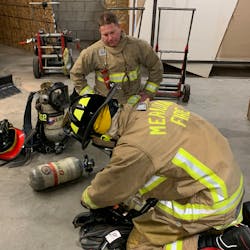Creating a Culture of Life Safety for the Fire Service
There is a need for changes within the fire service to foster life safety for personnel. One change requires improving the safety culture in fire departments: The behavior of fire service membership must reflect a collective consciousness and commitment to safety. The need for this change derives from the fact that a number of injuries and fatalities that occur in the fire service are largely predictable and, most often, preventable.
Another change: Implementing better integration of risk management with incident management at all levels, to mitigate situations that are unnecessarily high-risk, which might lead to what are often called “accidents.”
One more change: Providing the necessary support structures and assistance programs for EMS professionals and firefighters as well as their families. The nature of the work that’s carried out by the profession induces psychological and emotional stress, which might compromise members’ ability to perform at the required levels of proficiency and professionalism.
Safety culture
In their article, “Does the concept of safety culture help or hinder systems thinking in safety?” Teemu Reiman and Carl Rollenhagen note that although the idea that safety culture somehow represents a “systemic view” on safety, seldomly is it explicitly discussed. Nevertheless, it seems to linger behind many safety culture discourses. The behaviors of fire service personnel serve as an example in which such a view of safety culture should exist, but the prevalence of injuries and fatalities proves the contrary. According to the two authors, the latter might be influenced by the collective beliefs and meanings that members assign to organizational elements in a manner that influences personnel behavior. It then is incumbent on fire service organizations to instill organizational beliefs and values that facilitate the development of a safety culture that’s reflective of the nature of the work. The cultural dimension should be found in organizational strategies and structures as well as in administrative systems, constructing a social reality that fosters a safety-minded culture.
The development of safety culture is contingent on leadership, management systems and other human-related factors, such as learning, responsibility, values and attitudes. That means that the instigation of safety culture is a collective effort by fire service organizations and their personnel, which insinuates that there should be a desire and willingness from both participants to develop a safety culture.
According to Cindy Caldwell, who authored “Safety Culture and High-Risk Environments: A Leadership Perspective,” organizations must take a leadership role by articulating the attributes that clearly tie to the institution’s values and beliefs. First, the organizations must assess their organizational culture formally to identify their safety culture shortcomings. They must collect data about the attitudes, beliefs and values that inform personnel’s perspectives and behaviors regarding safety culture. The data then are analyzed and interpreted to help to formulate strategies and tactics for improving safety culture within the organization, and the strategies and tactics must be documented, Caldwell argues. The strategies and tactics can be tailored to the individual organization based on the outcomes of the data analysis and interpretation to suit the organization’s specific needs.
The needs of a fire service organization can be met only when the information/data that’s collected is accurate. Caldwell points out that the accuracy of the data depends on fostering an organizational environment that allows for open communication, organizational support for personnel and open engagement in the workplace. She adds that the latter are crucial ingredients to ensuring that organizational personnel adopt and commit to proposed changes. However, no strategy can guarantee an effective change, because the beliefs and attitudes of all personnel don’t align in every case. The risks that are involved in the fire service profession also are reflected in personnel’s attitudes, which affects the effectiveness of organizational culture.
Risk management
Managing the risk of the already-high-risk occupations in the fire service has become increasingly important, given that the percentage of total emergency-duty firefighter fatalities rose to 60 percent in 2019 from 52.4 percent in 2018, according to the U.S. Fire Administration. The percentage of firefighter fatalities has exhibited an upward trend since 2014, after peaking at 70.6 percent in 2013, which made 2019’s figure the second-highest of the decade. It’s even more alarming that 36 of the 62 fatalities that occurred in 2019 were caused by stress and overexertion, with the next highest cause (vehicle collision) claiming six lives. It’s clear that solutions that are developed through risk management are urgently necessary.
According to Gerald Poplin, who co-authored with others the article “Establishing a proactive safety and health risk management system in the fire service,” the conditions, equipment, environment and personnel that are involved in the high-risk work of the fire service must be thoroughly assessed during the process of finding risk-management solutions. The need for finding solutions is accentuated by the repetitive circumstances that lead to fatalities. The recurrence of fatalities because of stress and overexertion speaks to risk-mitigating factors that are lacking in the existing risk-management protocols. It’s imperative to investigate the factors that contribute to excessive stress, likely untreated, and fatal fatigue levels. Poplin and his co-authors argue that, although risk management aims to develop strategies that avoid loss and mitigate risk, current risk-management measures are failing dismally. They note that injuries that occur in the fire service not only are a regular concern, but they continue to be elevated, and new strategies are needed to aid in their prevention.
They write that when context is established in a risk-management approach, potential risks are identified, risks are assessed, potential treatment(s) of risk is designed and controls are implemented. This approach is segmented into three phases: scoping, risk assessment and implementation. The scoping phase entails establishing a context and identifying potential risks. The risk-assessment phase entails risk assessment and developing potential treatment(s) for risk. The implementation phase entails implementing controls and monitoring, reviewing and revising the implemented controls to safeguard against creating new unintended risk(s). All of the steps in these phases are taken through the utilization of constant communication and consultation, Poplin and his co-authors note.
Support mechanisms
Fire service personnel face high risks regularly, and this reality takes a toll on them physically, emotionally and mentally. Brandon Dreiman posits in his Firehouse Magazine article, “Firefighter Peer Support,” that suicide consideration is three times higher in firefighters than in the general population. The suicide attempt rate for firefighters is 16 percent compared with a maximum of 9 percent for the general population, Dreiman offers. The psychological strain is worsened by the life-threatening danger that comes with the job (e.g., cancer risks, mandatory/forced overtime, vehicle maintenance and budget constraints). He proposes the provision of behavioral health services for fire service personnel.
The provision of help in the form of support programs and behavioral and mental health services is essential to a successful fire service organization. Dreiman argues that firefighters suffer at a higher rate than the general population from behavioral disorders, including post-traumatic stress disorder (PTSD) and suicide-inducing behavioral health problems. He adds that the stigma around behavioral healthcare stops the vast majority of firefighters from seeking help for fear of sensitive information spreading throughout their department. Dreiman postulates that the peer support model can aid in remedying the situation. The peer support model engages firefighters in five areas:
- Peer support teams conduct “routine visits”
- Because peers are firefighters, they are more likely to be requested when assistance is needed than would be an outsider
- Peer support teams can visit crews easily after traumatic events and be welcomed into the firehouse to do so
- Peer support members engage other firefighters through a variety of educational efforts
- Peer support teams can develop and vet resources that firefighters can trust
Moving forward
Safety culture, risk management and support mechanisms in the fire service require changes to positively affect life safety for the fire service professional.
The establishment and improvement of a safety culture is crucial for any organization. It’s even more important in the fire service. Organizations and employees collectively must establish a safety culture that’s sustainable and that promotes behaviors that align with risk-management controls. These controls are developed to mitigate risk and to avoid loss of life. It’s important to develop and implement these protocols, because the major causes of line-of-duty fatalities are avoidable with the correct interventions. These interventions require the participation of organizations and personnel through open and constant communication and consultation.
We also now know that the high-risk nature of the fire service can lead to behavioral disorders and behavioral health care problems, but they can be addressed through communication and support.
As a profession, we must recognize and promote efforts to increase care and to reduce the stigma of risk management and mental health injuries. A collective shift in focus and mindset by organizations and personnel is required to reduce the number, frequency and severity of injuries and the number and frequency of fatalities.
About the Author

Kristopher Blume
Kristopher T. Blume is the fire chief of the Meridian, ID, Fire Department and has more than two decades of fire service experience. He is an author, lecturer and independent consultant. Blume is a graduate of the Executive Fire Officer (EFO) program and is an instructor at the National Fire Academy. As a student of the fire service, he is focused on values-driven, mission-focused leadership for the profession. He is the author of "Carry the Fire: The Crucible of Leadership in the Fire Service".
